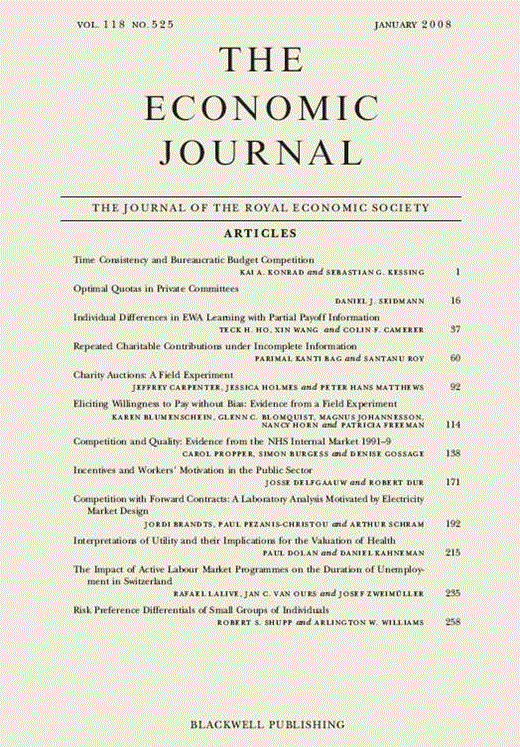The Fiscal and Welfare Effects of Immigration: Introduction
The impact of immigration on the tax and welfare system and the net fiscal consequences of immigration is perhaps the single most important economic issue of concern in the public debate assessing the pros and cons of immigration. For instance, (Dustmann and Preston 2005), in a data analysis for over 20 European countries, demonstrate that in assessments of immigration’s economic effects, concerns about the burden of migration on the public coffers outweigh those about labour market competition and economic efficiency. Similarly, using data for the UK only, (Dustmann and Preston 2007) show that concerns about immigrations’ fiscal effects have a larger impact on attitudes towards more liberal migration policies than concerns about its wage impacts. Interestingly, in line with these observations, it is concerns over immigration’s fiscal effects (and not so much its wage effects) that are currently dominating the debate in the UK and it was restrictions on welfare access that the UK government implemented just before opening up the UK labour market to A8 immigrants in 2004.1
Yet despite this apparent importance of fiscal considerations in the formation of attitudes towards immigration and, although the fiscal contribution of immigrants has emerged as a key concern in the public debate on immigration, very little evidence is yet available that allows assessment of how much immigrants take out of and contribute to the public purse. This Feature attempts to fill this void by presenting three papers on the subject: the first, by Preston, provides a conceptual framework, identifying the difficulties researchers face in investigating immigration’s fiscal effects because of problems in accurately allocating the related expenditures and revenues to different populations. This article thus sets the stage for the way we should think about empirical analyses that investigate immigrations’ fiscal impact and provides a valuable pre‐requisite not just for the more empirical papers in this Feature but also for the fiscal impact debate in general. In particular, it carefully separates the different impacts of immigration in both a static and a dynamic setting. Immigration can affect the static public budget constraint in various ways because immigrants pay taxes or consume public services differently from natives, change the taxes paid or services consumed by natives or, by their presence, affect the cost of providing services to natives. In a dynamic context, immigration can affect public finances by changing the generational composition of the population so that age groups with a positive fiscal balance shrink or expand relative to others.
The second and third articles, by Christian Dustmann and Tommaso Frattini and Bernt Bratsberg, Oddbjørn Raaum and Knut Røed, respectively, provide concrete empirical analyses on various aspects of the fiscal impact that immigration may have on receiving countries. These two articles focus on two countries that represent different ends of the generosity spectrum in terms of accessibility to welfare and transfer systems in Europe, the UK and Norway, two nations that also differ dramatically in the types of immigrants attracted over past decades. The two articles also represent two different modes of analysis for investigating immigration’s fiscal aspects. The first relies on repeated cross‐sectional survey data and rich supplementary data to assess the net fiscal contribution of different immigrant cohorts to the UK. The nature of these surveys is such that they provide sufficient information to enable such broad analysis, particularly by including items on transfer receipt and social housing. The second article, in contrast, draws on rich longitudinal administrative data that, while providing less information on immigrants’ personal characteristics, do follow individual immigrants from entry into the host country until the most recent point in time covered by the data. Thus, besides investigating two very different countries, these two articles also illustrate different types of analysis that are feasible with different types of data. More specifically, whereas Dustmann and Frattini, allocate all expenditures and tax revenues to natives and different immigrant populations, and then calculate the net fiscal impact of immigration, Bratsberg et al. focus on labour earnings and social insurance transfers, and then analyse the differences in lifecycle employment and welfare receipt between natives and different cohorts of immigrants and their descendants.
Despite these differences, however, both articles draw a fascinatingly diverse picture of immigrations’ fiscal impact on the receiving countries. In terms of the different types of immigrants attracted to the two countries, immigrants to the UK tend on average to be highly skilled, whereas those to Norway appear less so. In fact, Dustmann and Frattini show that the average level of education, as well as the share of individuals with a tertiary education, has been consistently higher in the UK’s immigrant population than among natives and that this difference has accelerated with the arrival of new immigrants since 2000. In addition, immigrant populations in the UK have a high labour market attachment, with employment rates on average similar to those of natives (although with some heterogeneity between immigrants from the European Economic Area (EEA) versus non‐EEA immigrants). Immigrants to Norway, in contrast, are typically far less skilled than natives, so the employment rates of all groups studied fall below those of natives, with some groups experiencing a sharp rise in non‐employment a few years after arrival. Not surprisingly, therefore, the conclusions drawn by these two articles are radically different. The picture that emerges is that whereas post‐2000 immigrants to Britain have made a substantial net fiscal contribution, immigrants to Norway have been drawing far more heavily on certain key welfare transfers than natives. Nevertheless, the authors identify considerable heterogeneity between different non‐EEA immigrant groups to Norway, with immigrants from Sri Lanka, Vietnam and the Balkans doing relatively well.
One conclusion that Bratsberg et al. draw from the Norwegian analysis is that the generosity of the Norwegian welfare system may create important disincentive effects for low‐skilled immigrants, and may partly be responsible for the dismal performance and high transfer dependence of some immigrant groups. But this same generosity seems also to affect Norwegians, with, for instance, more than 20% of native born women in the age range between 25 and 64 claiming disability benefits in 2012. On the other hand, second immigrant generations have more favourable economic outcomes than their parents.
The picture for the UK, on the other hand, is quite different, particularly for immigrants arriving after 2000. These immigrants are substantially less likely to receive any transfers of benefits than natives, even when their more favourable age structure is controlled for. Overall, the post‐2000 immigrants made a very significant net fiscal contribution between 2001 and 2011. In contrast, over the same period, the total tax payments of UK natives were 10% lower than the transfers they received. The article by Dustmann and Frattini also emphasises an aspect of immigration that is usually neglected: immigrants typically arrive at the start of their productive period and after completion of their full time education. The education acquired and financed by the countries of origin constitutes a considerable savings for the receiving countries. For the UK, Dustmann and Frattini propose an annuity‐based methodology that computes the savings for each year immigrants are active in the UK labour market, taking account of the fact that immigrants often work in jobs that do not correspond to their measured education. They conclude that these savings can be substantial.
Nevertheless, despite the favourable position of the UK in terms of immigrants’ welfare dependence, public opinion polls point to higher concerns about immigration in the UK than in Norway. For instance, according to the 2010 European Social Survey, 44% of the UK population believes that immigration is bad for their country’s economy, while only 25% of the Norwegian population share the same opinion. Likewise, when asked how many immigrants from poorer countries outside Europe should be allowed to enter the country, 21% of UK residents responded that no immigrants from poorer countries should be let in, while only 5% of the Norwegian population gave the same answer. In addition, and at odds with the evidence reported in this Feature by Dustmann and Frattini, responses to the 2008 European Social Survey show that while 56% of the UK residents believe that immigrants are net recipients of welfare expenditure, such is only the case for 47% of the Norwegian population. One important and interesting avenue for future research, therefore, would be to increase understanding of how the mismatch arises between the perception and reality of immigration and its impact on the receiving country, and how these differences may be instigated or reduced by policy and informed public debate.
Footnotes
1) A8 immigrants are those from the eight Central and Eastern European countries that joined the EU in May 2004.
References
Bratsberg, B., Raaum, O. and Roed, K. (2014). ‘Immigrants, labour market performance, and social insurance’, Economic Journal , vol. 124(580), pp. F644–83.
Dustmann, C. and Frattini, T. (2014). ‘The fiscal effects of immigration to the UK’, Economic Journal , vol. 124(580), pp. F593–643.
Dustmann, C. and Preston, I. (2005), ‘Is immigration good or bad for the economy? Analysis of attitudinal responses’, Research in Labor Economics , vol. 24, pp. 3–34.
Dustmann, C. and Preston, I. (2007). ‘Racial and economic factors in attitudes to immigration’, B.E. Journal of Economic Analysis & Policy , vol. 7(1), pp. 1–41, (Advances), Article 62.
Preston, I. (2014). ‘The effect of immigration on public finances’, Economic Journal , vol. 124(580), pp. F569–92.

